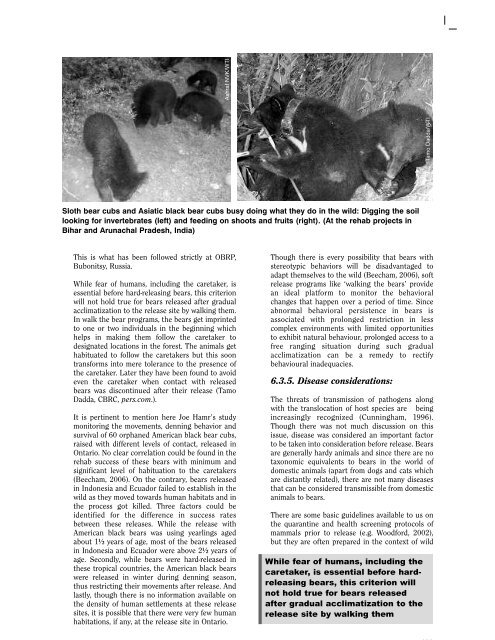Walking The Bears.pdf
Walking The Bears.pdf
Walking The Bears.pdf
- TAGS
- walking
- www.ifaw.org
You also want an ePaper? Increase the reach of your titles
YUMPU automatically turns print PDFs into web optimized ePapers that Google loves.
AshrafNVK/WTI<br />
Sloth bear cubs and Asiatic black bear cubs busy doing what they do in the wild: Digging the soil<br />
looking for invertebrates (left) and feeding on shoots and fruits (right). (At the rehab projects in<br />
Bihar and Arunachal Pradesh, India)<br />
This is what has been followed strictly at OBRP,<br />
Bubonitsy, Russia.<br />
While fear of humans, including the caretaker, is<br />
essential before hard-releasing bears, this criterion<br />
will not hold true for bears released after gradual<br />
acclimatizationtothereleasesitebywalkingthem.<br />
In walk the bear programs, the bears get imprinted<br />
to one or two individuals in the beginning which<br />
helps in making them follow the caretaker to<br />
designated locations in the forest. <strong>The</strong> animals get<br />
habituated to follow the caretakers but this soon<br />
transforms into mere tolerance to the presence of<br />
the caretaker. Later they have been found to avoid<br />
even the caretaker when contact with released<br />
bears was discontinued after their release (Tamo<br />
Dadda, CBRC, pers.com.).<br />
It is pertinent to mention here Joe Hamr’s study<br />
monitoring the movements, denning behavior and<br />
survival of 60 orphaned American black bear cubs,<br />
raised with different levels of contact, released in<br />
Ontario. No clear correlation could be found in the<br />
rehab success of these bears with minimum and<br />
significant level of habituation to the caretakers<br />
(Beecham, 2006). On the contrary, bears released<br />
in Indonesia and Ecuador failed to establish in the<br />
wild as they moved towards human habitats and in<br />
the process got killed. Three factors could be<br />
identified for the difference in success rates<br />
between these releases. While the release with<br />
American black bears was using yearlings aged<br />
about 1½ years of age, most of the bears released<br />
in Indonesia and Ecuador were above 2½ years of<br />
age. Secondly, while bears were hard-released in<br />
these tropical countries, the American black bears<br />
were released in winter during denning season,<br />
thus restricting their movements after release. And<br />
lastly, though there is no information available on<br />
the density of human settlements at these release<br />
sites, it is possible that there were very few human<br />
habitations, if any, at the release site in Ontario.<br />
Though there is every possibility that bears with<br />
stereotypic behaviors will be disadvantaged to<br />
adapt themselves to the wild (Beecham, 2006), soft<br />
release programs like ‘walking the bears’ provide<br />
an ideal platform to monitor the behavioral<br />
changes that happen over a period of time. Since<br />
abnormal behavioral persistence in bears is<br />
associated with prolonged restriction in less<br />
complex environments with limited opportunities<br />
to exhibit natural behaviour, prolonged access to a<br />
free ranging situation during such gradual<br />
acclimatization can be a remedy to rectify<br />
behavioural inadequacies.<br />
6.3.5. Disease considerations:<br />
<strong>The</strong> threats of transmission of pathogens along<br />
with the translocation of host species are being<br />
increasingly recognized (Cunningham, 1996).<br />
Though there was not much discussion on this<br />
issue, disease was considered an important factor<br />
tobetakenintoconsiderationbeforerelease.<strong>Bears</strong><br />
are generally hardy animals and since there are no<br />
taxonomic equivalents to bears in the world of<br />
domestic animals (apart from dogs and cats which<br />
are distantly related), there are not many diseases<br />
thatcanbeconsideredtransmissiblefromdomestic<br />
animals to bears.<br />
<strong>The</strong>re are some basic guidelines available to us on<br />
the quarantine and health screening protocols of<br />
mammals prior to release (e.g. Woodford, 2002),<br />
but they are often prepared in the context of wild<br />
Whilefearofhumans,includingthe<br />
caretaker,isessentialbeforehardreleasingbears,thiscriterionwill<br />
notholdtrueforbearsreleased<br />
aftergradualacclimatizationtothe<br />
releasesitebywalkingthem<br />
TamoDadda/WTI

















